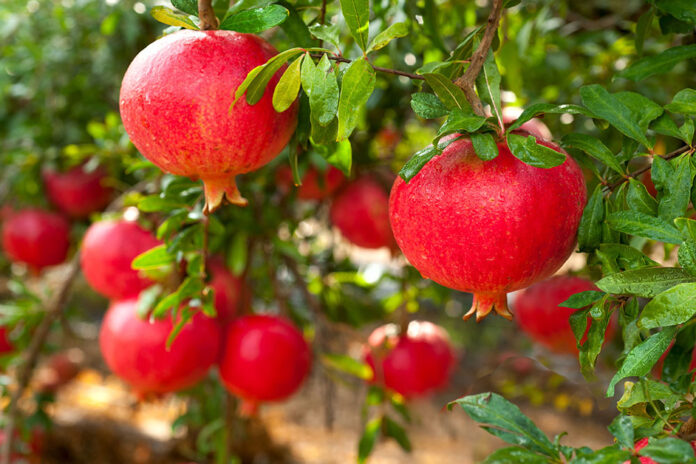

By Scott Oliver
Maricopa Master Gardeners are developing a new demonstration orchard at the Maricopa Agricultural Center.
Irrigation has been installed; citrus trees are in the ground. Our purpose is to demonstrate, using “backyard orchard culture” techniques to successfully grow a variety of fruit in a small space. In the spring, we will plant stone and seed fruit trees. We also plan to trial several varieties of pomegranates.
Here’s why:
Pomegranates are easy to grow, have beautiful flowers and are well-suited to our desert environment. They are native to southeastern Europe and Asia and have been cultivated in ancient Egypt, Babylonia, India and Iran. The Spanish brought them to Mexico, California and Arizona in the 16th century.
Although pomegranates have not attained the popularity of other fruits in the United States, they are worthy of a place in your backyard garden.
Pomegranates (Punica granatum) grow as woody plants that more closely resemble shrubs than trees. Mature plants are usually 6-12 feet tall and can easily be trained to a tree form or espaliered against a wall or fence. Pomegranate plants are deciduous, have small oval leaves and are somewhat thorny. They require full sun and tolerate our alkaline soils, summer heat and winter lows to 10 degrees F. They are somewhat drought-tolerant but should be irrigated like other fruit trees for optimum fruit quality.
Mature fruits are 2-5 inches in diameter and have purple to reddish skin (some varieties are pink). The fruits resemble apples but are actually berries and ripen in August and September. Inside the tough outer skin are hundreds of seeds, each surrounded by a membrane that encloses a juicy pulp. This is the edible portion of the plant.
Plants are available from nurseries and garden centers usually in five-gallon containers. “Wonderful” is the best fruiting variety for our area.
To propagate from cuttings, remove shoots 6-8 inches long that are the diameter of a pencil or larger. Cuttings should be taken in February or March and placed vertically in soil with the top, dormant bud exposed. Dusting with rooting hormone on the cut end will enhance root formation.
Pomegranates are shrubby because they produce many suckers from the root and crown area. To encourage a tree-like form, select one trunk and remove suckers on a regular basis. Once established, applying a balanced fertilizer can enhance fruit quality and plant vigor. Young trees should receive about two pounds of 10-10-10 or similar in November and March. Mature trees can use twice this amount applied at the same times.
Scott Oliver is retired from Pacific Bell Telephone Company and a member of Maricopa Master Gardeners.
This column appears in the December issue of InMaricopa.













![Alleged car thief released without charges Phoenix police stop a stolen vehicle on April 20, 2024. [Facebook]](https://www.inmaricopa.com/wp-content/uploads/2024/04/IMG_5040-218x150.jpg)


![Maricopa’s ‘TikTok Rizz Party,’ explained One of several flyers for a "TikTok rizz party" is taped to a door in the Maricopa Business Center along Honeycutt Road on April 23, 2024. [Monica D. Spencer]](https://www.inmaricopa.com/wp-content/uploads/2024/04/spencer-042324-tiktok-rizz-party-flyer-web-100x70.jpg)
